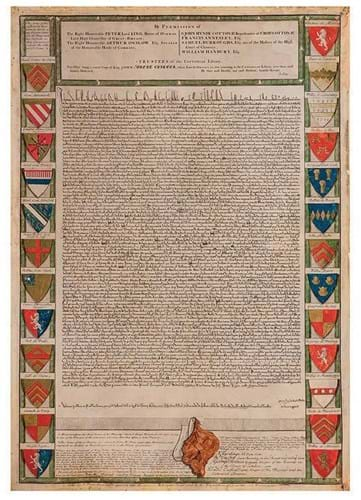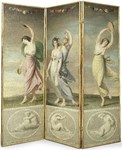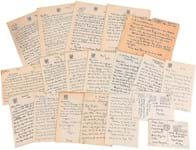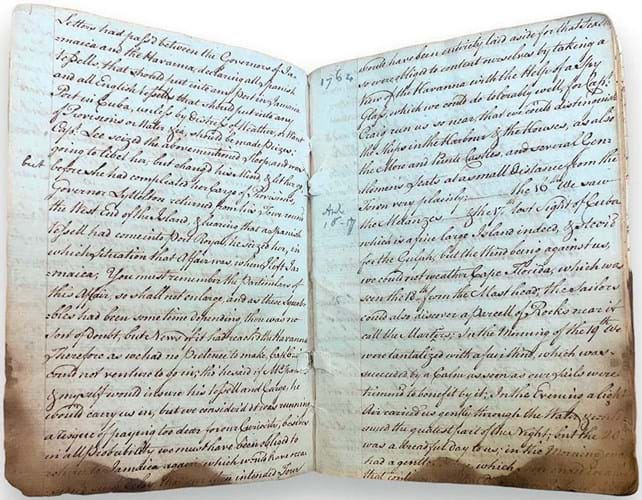
Manuscript account of a journey made by two Englishmen and their two black servants across colonial America, £24,000 at Chiswick Auctions.
An apparently unpublished account of a journey made by two Englishmen across colonial North America was the surprise best-selling lot at Chiswick Auctions (25% buyer’s premium) in west London on November 29.
Joseph Cator (1733-1818) and Joseph Sparkes had spent four months travelling by horse and carriage from Charleston to Boston accompanied by two black servants, Tancred and Caesar.
The 88-page manuscript, which carries Cator’s bookplate, is thought be a copy of a letter he wrote to a friend (the name now sadly illegible). The brother of a timber merchant and an MP in Kent, Cator had left native soil for the sugar plantations of Jamaica c.1754, aged 21.
The account of his return home a decade later begins in the West Indies in April 1764 with the chartering of a boat to South Carolina.
In ‘Charles Town’ they were received by Henry Laurens (1724- 92), a merchant, slave trader and member of South Carolina’s colonial assembly who provided them with the letters of introduction that eased their passage along the eastern seaboard: “Be so kind to give them your countenance and aid if requisite as they pass by your door. If they have occasion for Cash their Bills upon me shall by duly honoured.”.
Cator used the text to note the places he and his entourage visited, the produce of each area, notable buildings, the people they met, hospitality they received and incidents on the road. Having passed through the Carolinas, Virginia, Maryland, Pennsylvania, West Jersey, New York, Connecticut, Rhode Island and Massachusetts, they arrived in Boston on July 9.
Such a descriptive account of life in America a decade before the stirrings of revolution had obvious appeal to buyers across the Atlantic. The winning bidder at £24,000, many times the pre-sale estimate of £2000-3000, was from Massachusetts.
Magna Carta copy
A rare early 18th century printing of the original text of Magna Carta sold at £12,000 (estimate £6000-8000). This vellum copy of the most celebrated legal document in the English-speaking world was published in 1733 by John Pine (1690-1756), two years after the celebrated Sir Robert Cotton library of manuscripts was hit by a fire.
While Cotton’s two copies of Magna Carta survived, they were damaged. For posterity and for commercial opportunity, Pine chose to copy one of them, meticulously including a facsimile of the remnants of King John’s Great Seal melted by the heat form the fire. He embellished the engraving by adding the 25 coats of arms of the barons who had forced King John to sign the document.
The first impressions of the engraving were printed on vellum, as here, with a later second state printed on paper.
Royal residences
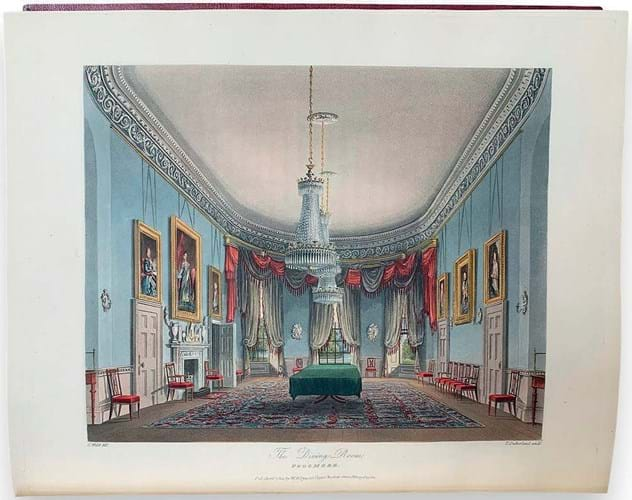
The Dining Room, Frogmore from William Henry Pyne’s The History of the Royal Residences, £3000 at Chiswick Auctions.
Estimated at £2000-3000 and sold at the top estimate was William Henry Pyne’s The History of the Royal Residences of Windsor Castle, St. James’s Palace, Carlton House, Kensington Palace, Hampton Court, Buckingham House, and Frogmore.
Published in 1819, the three volumes include 100 hand-coloured aquatint plates that were bound here by Sangorski & Sutcliffe in modern morocco gilt.
Intrepid traveller
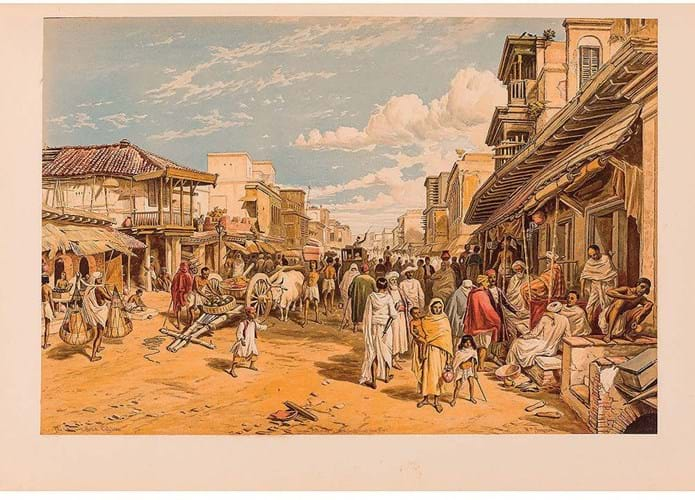
One of the large folio plates from India Ancient and Modern, published in 1867 by William Simpson and Sir John William Kaye, £15,000 at Chiswick Auctions.
India Ancient and Modern is a rare large folio edition published in 1867 by William Simpson and Sir John William Kaye. Simpson had been sent to India on a roving commission to produce drawings and paintings for the project and – from arrival Calcutta in October 1859 to departure from Bombay in February 1862 – spent two and a half years travelling the subcontinent.
An intrepid fellow, he visited places in the north of the country that few westerners had seen, later recalling: “The ordinary traveller who ‘does’ India sees Bombay, Calcutta, Benares, Agra, and Delhi, but in the vast spaces between these noted places he sees nothing of. It is in these spaces that the real India exists.’’
The fruits of his labour were 50 chromo-lithographed plates mounted on card, offered here with a guide of £15,000-20,000. It is a scarce work but it took the low estimate.
Another copy offered by Forum Auctions brought £18,000 in 2021 and one took £30,000 at Sotheby’s in November 2008.
Suffolk witch trial

A Tryal of Witches at the Assizes Held at Bury St. Edmunds for the County of Suffolk, £3200 at Chiswick Auctions.
A rare eyewitness account of a witchcraft trial sold at £3300 in Chiswick.
A Tryal of Witches at the Assizes Held at Bury St. Edmunds for the County of Suffolk was printed in London in 1682, the year presiding judge Sir Matthew Hale died. However, it deals with the trial of Rose Cullender and Amy Duny conducted 18 years earlier in March 1664.
The widows, from Lowestoft, had been accused of witchcraft by their neighbours and faced 13 charges of bewitching children – the youngest only a few months old and the eldest 18 – one of whom had died.
Tried at the assizes under the 1603 Witchcraft Act, they were found guilty on all 13 charges of using malevolent witchcraft and sentenced to be hanged.
Sir Matthew believed wholeheartedly in the menace of witches and used the hearsay evidence of children and the ‘spectral’ evidence of visions and dreams to secure convictions.
His instructions to the jurors at Bury St Edmunds, recorded in this pamphlet, were studied carefully by the judges of New England during the famous witch trials held in colonial Massachusetts between early 1692 and mid-1693 when more than 200 people from Salem were accused and 20 were executed.
Essex auction house Sworders sold another copy of this pamphlet in January 2020 for £5400.
Cook’s final voyage
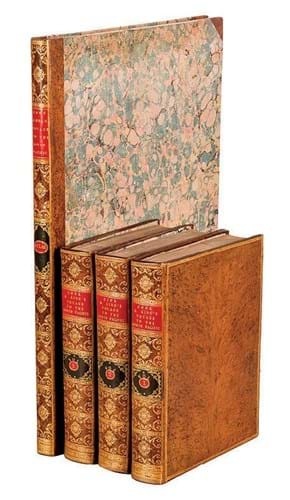
First edition of A Voyage to the Pacific Ocean…, documenting Cook’s third voyage, £5500 at Chiswick Auctions.
A fine 1784 first edition of A Voyage to the Pacific Ocean…, the official account of the voyage to the North Pacific during which Captain James Cook lost his life, sold just below the estimate at £5500.
The so-called ‘third voyage’ was as important for the exploration of the North Pacific as the first two had been for the South Pacific. The best equipped expedition both navigationally and scientifically, it resulted in the discovery of Hawaii which Cook himself regarded as his greatest Pacific discovery and put to bed the idea of a navigable northern passage from the Atlantic to the Pacific.
However, after its tragic conclusion (Cook was killed in a shoreline skirmish with the native Hawaiians in 1779), the official account of the voyage was long-delayed. So eagerly was it awaited by the public that it sold out on the third day after publication, and though the published price was £4. 14s. 6d. they changed hands for as much as 10 guineas
This copy, retaining the requisite series of charts and engraved plates, was uniformly bound in half tree calf with red and green letter-pieces.


